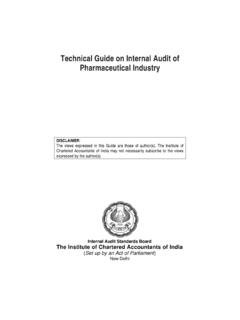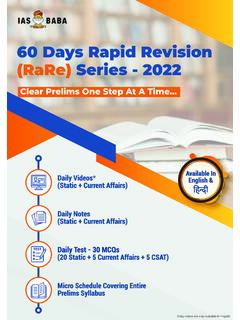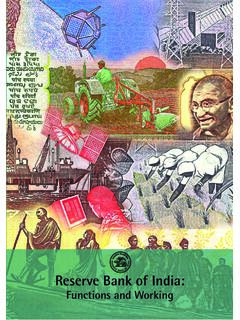Transcription of INDIA’S STRUGGLE FOR INDEPENDENCE 1857-1947
1 india S STRUGGLE FOR INDEPENDENCE 1857-1947 BIPAN CHANDRA MRIDULA MUKHERJEE ADITYA MUKHERJEE K N PANIKKAR SUCHETA MAHAJAN Penguin Books CONTENTS INTRODUCTION 1. THE FIRST MAJOR CHALLENGE: THE REVOLT OF 1857 2. CIVIL REBELLIONS AND TRIBAL UPRISINGS 3. PEASANT MOVEMENTS AND UPRISINGS AFTER 1857 4. FOUNDATION OF THE CONGRESS: THE MYTH 5. FOUNDATION OF THE INDIAN NATIONAL CONGRESS: THE REALITY 6. SOCIO-RELIGIOUS REFORMS AND THE NATIONAL AWAKENING 7. AN ECONOMIC CRITIQUE OF COLONIALISM 8. THE FIGHT TO SECURE PRESS FREEDOM 9. PROPAGANDA IN THE LEGISLATURES 10. THE SWADESHI MOVEMENT 1903-08 11.
2 THE SPLIT IN THE CONGRESS AND THE RISE OF REVOLUTIONARY TERRORISM 12. WORLD WAR I AND INDIAN NATIONALISM: THE GHADAR 13. THE HOME RULE MOVEMENT AND ITS FALLOUT 14. GANDHIJI S EARLY CAREER AND ACTIVISM 15. THE NON-COOPERATION MOVEMENT 1920-22 16. PEASANT MOVEMENTS AND NATIONALISM IN THE 1920 S 17. THE INDIAN WORKING CLASS AND THE NATIONAL MOVEMENT 18. THE STRUGGLES FOR GURDWARA REFORM AND TEMPLE ENTRY 19. THE YEARS OF STAGNATION SWARAJISTS, NO-CHANGERS AND GANDHIJI 20. BHAGAT SINGH, SURYA SEN AND THE REVOLUTIONARY TERRORISTS 21. THE GATHERING STORM 1927-29 22. CIVIL DISOBEDIENCE 1930-31 23.
3 FROM KARACHI TO WARDHA: THE YEARS FROM 1932-34 24. THE RISE OF THE LEFT-WING 25. THE STRATEGIC DEBATE 1935-37 26. TWENTY-EIGHT MONTHS OF CONGRESS RULE 27. PEASANT MOVEMENTS IN THE 1930s AND 40s 28. THE FREEDOM STRUGGLE IN PRINCELY india 29. INDIAN CAPITALISTS AND THE NATIONAL MOVEMENT 30. THE DEVELOPMENT OF A NATIONALIST FOREIGN POLICY 31. THE RISE AND GROWTH OF COMMUNALISM 32. COMMUNALISM-THE LIBERAL PHASE 33. JINNAH, GOLWALKAR AND EXTREME COMMUNALISM 34. THE CRISIS AT TRIPURI TO THE CRIPPS MISSION 35. THE QUIT india MOVEMENT AND THE INA 36. post -WAR NATIONAL UPSURGE 37. FREEDOM AND PARTITION 38. THE LONG-TERM STRATEGY OF THE NATIONAL MOVEMENT 39. THE INDIAN NATIONAL MOVEMENT: THE IDEOLOGICAL DIMENSION 1 |Introduction INTRODUCTION The Indian national movement was undoubtedly one of the biggest mass movements modern Society has ever seen, It was a movement which galvanized millions of People of all classes and ideologies into political action and brought to its knees a mighty colonial empire.
4 Consequently, along with the British, French, Russian, Chine, Cuban and Vietnam revolutions, it is of great relevance to those wishing to alter the existing political and social structure. Various aspects of the Indian national movement, especially Gandhian political strategy, are particularly relevant to these movements in societies that broadly function within the confines of the rule of law, and are characterized by a democratic and basically civil libertarian polity. But it is also relevant to other societies. We know for a fact that even Lech Walesa consciously tried to incorporate elements of Gandhian strategy in the Solidarity Movement in Poland.
5 The Indian national movement, in fact, provides the only actual historical example of a semi-democratic or democratic type of political structure being successfully replaced or transformed. It is the only movement where the broadly Gramscian theoretical perspective of position was successfully practiced a war in a single historical moment of revolution, but through prolonged popular STRUGGLE on a moral, political and ideological level; where reserves of counter hegemony were built up over the years through progressive stages; where the phases of STRUGGLE alternated with passive phases. The Indian national movement is also an example of how the constitutional space offered by the existing structure could be used without getting co-opted by it.
6 It did not completely reject this space; as such rejection in democratic societies entails heavy costs in terms of hegemonic influence and often leads to isolation 2 | india s STRUGGLE for INDEPENDENCE but entered it and used it effectively in combination with non-constitutional STRUGGLE to overthrow the existing structure. The Indian national movement is perhaps one of the best examples of the creation of an extremely wide movement with a common aim in which diverse political and ideological currents could exist and work and simultaneously continue to contend for overall ideological political hegemony over it. While intense debate on all basic Issues was allowed, the diversity and tension did not weaken the cohesion and striking power of the movement; on the contrary, this diversity and atmosphere of freedom and debate became a major source of its strength.
7 Today, over forty years after INDEPENDENCE , we are still close enough to the freedom STRUGGLE to feel its warmth and yet far enough to be able to analyze it coolly, and with the advantage of hindsight. Analyze it we must, for our past, present and future are inextricably linked to it. Men and women in every age and society make their own history, but they do not make it in a historical vacuum, de novo. Their efforts, however innovative, at finding solutions to their problems in the present and charting out their future, are guided and circumscribed, moulded and conditioned, by their respective histories, their inherited economic, political and ideological structures.
8 To make myself clearer, the path that india has followed since 1947 has deep roots in the STRUGGLE for INDEPENDENCE . The political and ideological features, which have had a decisive impact on post - INDEPENDENCE development, are largely a legacy of the freedom STRUGGLE . It is a legacy that belongs to all the Indian people, regardless of which party or group they belong to now, for the party which led this STRUGGLE from 1885 to 1947 was not then a party but a movement all political trends from the Right to the Left were incorporated in it. * What are the outstanding features of the freedom STRUGGLE ? A major aspect is the values and modern ideals on which the movement itself was based and the broad socio-economic and political vision of its leadership (this vision was that of a democratic, civil libertarian and secular india , based on a self-reliant, egalitarian social order and an independent foreign 3 |Introduction policy).
9 The movement popularized democratic ideas and institutions in india . The nationalists fought for the introduction of a representative government on the basis of popular elections and demanded that elections be based on adult franchise. The Indian National Congress was organized on a democratic basis and in the form of a parliament. It not only permitted but encouraged free expression of opinion within the party and the movement; some of the most important decisions in its history were taken after heated debates and on the basis of open voting. From the beginning the nationalists fought against attacks by the State on the freedoms of the Press, expression and association, and made the STRUGGLE for these freedoms an integral part of the national movement.
10 During their brief spell in power, from 1937-39, the Congress ministries greatly extended the scope of civil liberties. The defence of civil liberties was not narrowly conceived in terms of one political group, but was extended to include the defence of other groups whose views were politically and ideologically different. The Moderates defended Tilak, the Extremist, and non-violent Congressmen passionately defended revolutionary terrorists and communists alike during their trials. In 1928, the Public Safety Bill and Trade Disputes Bill were opposed not only by Motilal Nehru but also by conservatives like Madan Mohan Malaviya and Jayakar. It was this strong civil libertarian and democratic tradition of the national movement which was reflected in the Constitution of independent india .





